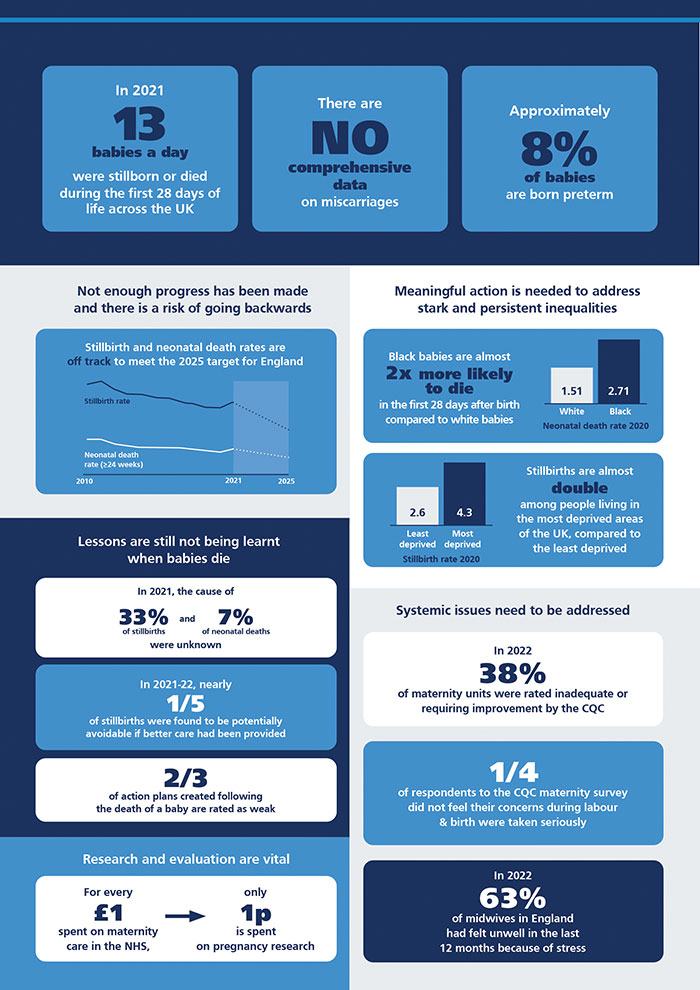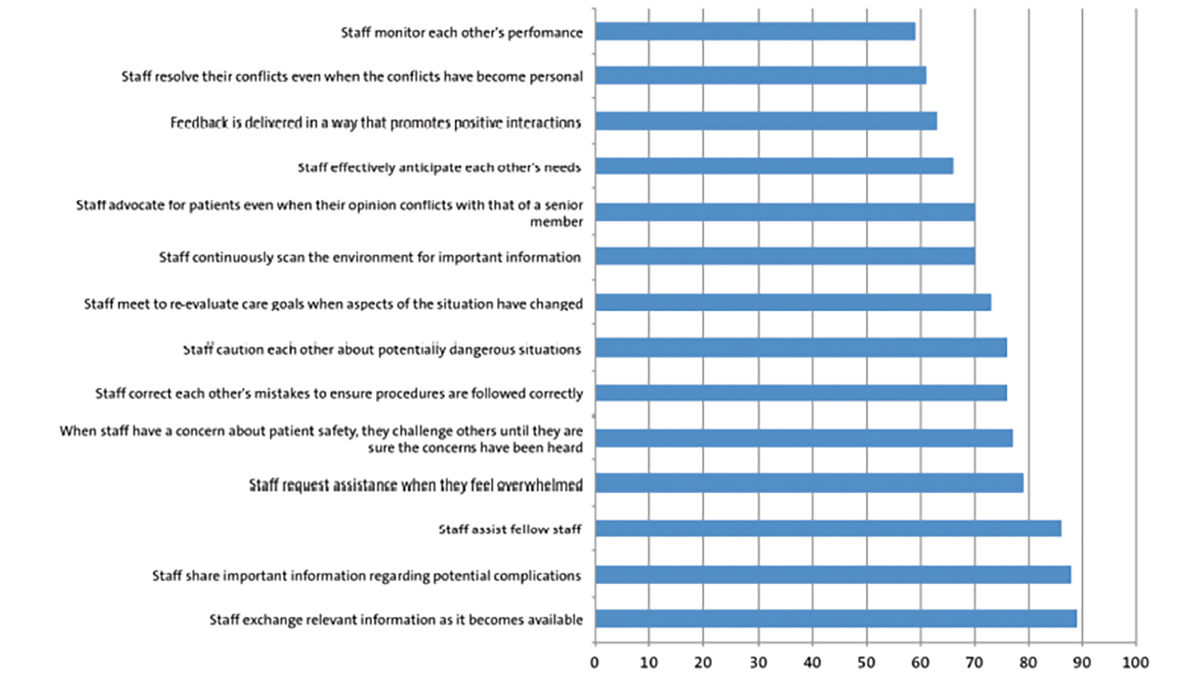Too many families continue to suffer the heartbreak of losing a baby
Every day in the UK, around 13 families suffer the heartbreak of losing their baby before, during or shortly after birth. Furthermore, an estimated one in six pregnancies end in miscarriage, although this is very likely to be an underestimate as comprehensive data on miscarriage are not currently available. Losing a baby during pregnancy or shortly after birth is not a tragic inevitability. Being born preterm is an important risk factor for neonatal death, yet there has been little progress to reduce the proportion of babies who are born prematurely – around 50,000 babies each year.
Robert Wilson
Head of Sands and Tommy’s Joint Policy Unit
Georgia Stevenson
Data and Evidence Lead, Sands and Tommy’s Joint Policy Unit
Published by the Sands and Tommy’s Joint Policy Unit, the Saving Babies’ Lives Progress Report pulls together data from different sources for the first time to give a shared understanding of the burden of pregnancy and baby loss across the UK (FIGURE 1). Outlining recent trends and evidence, as well as gaps in current information, the report sets out areas where further work is required to reduce rates of miscarriage, stillbirth, preterm birth and neonatal death.

FIGURE 1 The Saving Babies’ Lives Progress Report summary infographic.
This is the first in a series of progress reports from the Sands and Tommy’s Joint Policy Unit, aimed at policymakers from the government and the NHS, charities and professional bodies. Over time, the charities will monitor progress and report on the work that is being done to support policy change that will save more babies’ lives and help tackle inequalities.
Overall, the report paints a concerning picture; not enough progress has been made to reduce rates of pregnancy loss and baby death across the UK, and there is a risk of going backwards. In England the government’s target to halve the number of stillbirths and neonatal deaths by 2025 compared to 2010 levels is not on track, and there is no current target or ambition for reducing baby deaths in Scotland, Wales or Northern Ireland. Progress on reducing pregnancy loss and baby death goes hand-in-hand with other issues in maternal and neonatal services, including worsening maternal mortality rates, quality and safety of services, and families’ engagement and satisfaction. The report calls for saving babies’ lives and reducing inequalities to become the national policy priorities they deserve to be.
Factors associated with deaths are complex and changing
There are a range of characteristics associated with higher risk of pregnancy loss or the death of a baby, for example: birth weight, gestational age and whether the baby is a singleton or multiple pregnancy; maternal age, health behaviours and existing medical conditions; ethnicity and deprivation. The changing profile of the birthing population and increasing clinical knowledge of the different factors affecting pregnancy has implications for risk assessment, monitoring and the care and resources required. It is important that health services are set up to provide care and support that are tailored to an individual’s needs.
Systemic issues need to be addressed to meet government commitments
The report highlights that, despite government commitments to act on the findings of recent reviews of maternity services, this still hasn’t led to the fundamental changes needed to save more babies’ lives. For example:
- Nationally-agreed standards of care are often not being followed, which is contributing to avoidable deaths.
- Staff report working in an increasingly under resourced and stretched system, which is having an impact on people’s experience of care.
- Many NHS trusts and boards are still not learning from the mistakes that cost lives when things go wrong.
- The voices of bereaved parents are still not being effectively heard and acted upon.
Systemic issues in maternity and neonatal services need to be addressed; we need a much more comprehensive approach to supporting improvements in maternity and neonatal services. To make the UK a safer place to have a baby we need to:
Invest in research and evaluation
Research and evaluation are vital for improving outcomes in the future, yet relatively little is invested in pregnancy-related research. For every £1 spent on maternity care in the NHS, only 1p is spent on pregnancy research. Most research funding has focused on discovery research, clinical trials and observational research, which are all critical for understanding causes of pregnancy and baby loss and investigating solutions to reduce their occurrence. However, other areas receive significantly less funding including social science, economic analysis and policy research, which are critical to evaluating existing interventions. Improving the quality and consistency of routine data collection is vital for evidence-based research. More research is needed to understand the causes of pregnancy loss and baby death, as well as monitoring the number of losses. Robust monitoring and reporting of all pregnancy loss and baby deaths, including miscarriages, is important to set meaningful targets for reduction and to evaluate the impact of policy initiatives. Research and evaluation must include engagement with bereaved parents and people at risk of the worst maternal and neonatal outcomes. We need policies which encourage the midwifery and neonatal workforce to engage with and lead research and find approaches that meet the needs of families and healthcare professionals.
Tackle inequalities across ethnicity and deprivation
Stillbirths, neonatal deaths and preterm births are more common among babies from minoritised ethnic groups. Black British babies are over two times more likely to be stillborn and over 1.7 times more likely to die during the first 28 days after birth, compared to white babies. Black ethnicity is associated with a 43% higher risk of miscarriage compared to white ethnicity. Living in a more deprived area is also associated with higher risk of stillbirth and neonatal death. Stillbirth rates are almost two times higher among those living in the most deprived areas, compared to the least deprived. Some ethnic groups are more likely to live in more deprived areas; however, this alone is not sufficient to explain inequalities. Even after adjusting for the level of deprivation, differences in stillbirth rates across ethnic groups remain.
Meaningful action is needed to address stark and persistent inequalities by ethnicity and deprivation. There are also no national targets or long-term funding to reduce inequalities between ethnic groups or areas of deprivation. There needs to be a much stronger commitment, and long-term funding, from government to eliminating inequalities in pregnancy loss and baby deaths.
Learn lessons when babies die
Understanding the cause of deaths is essential to preventing future deaths. There is a lot we don’t know. In 2021, the causes of 33% of stillbirths and 7% of neonatal deaths were unknown. In addition to understanding the clinical causes of a death, hospital reviews and external investigations are important to identify where better care could have prevented deaths. Nearly a fifth of stillbirths that were reviewed using the National Perinatal Mortality Review Tool (PMRT) in 2021-22 were found to be potentially avoidable if better care had been provided. Findings from the PMRT should be used to inform service improvement action plans, but information from the PMRT is not currently being used effectively enough by the health system.
Ensure adequate resourcing
Adequate resources must be put in place to ensure everyone can access best practice care. This includes sufficient staffing levels to allow healthcare professionals to listen to and build relationships with women and birthing people. Beyond staffing levels, there is a need for culture change to ensure openness, learning and transparency. We need to move from diagnosing issues with team work and culture, to introducing effective interventions to address them.
Collaborating to make the UK the safest place in the world to have a baby
At the heart of the Saving Babies’ Lives report are the voices of bereaved parents and other family members. It is so important for anyone affected by pregnancy loss or the death of a baby to know that they will be listened to and their experiences will lead to changes that save future lives. There is a long way to go to make the UK the safest place in the world to have a baby. We all want safer, more personalised, more equitable care so that fewer people suffer the heartbreak of losing a baby. This is possible with political will, common purpose and collaboration, and the Sands and Tommy’s Joint Policy Unit is committed to working constructively with government and policymakers to secure change that will save more babies’ lives in the future.
To read the report visit:
Or read this article in our
Tablet/iPad edition


